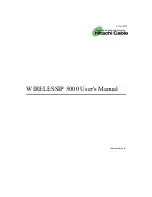
1-6
Cisco MGCP IP Phone Administrator Guide, Release 6.x and 7.x
Chapter 1 Product Overview
Media Gateway Control Protocol Overview
Media Gateway Control Protocol Overview
Media Gateway Control Protocol (MGCP) is the Internet Engineering Task Force (IETF) standard for
multimedia conferencing over IP. MGCP is an ASCII-based, application-layer control protocol (defined
in RFC 2705) that can be used to establish, maintain, and terminate calls between two or more endpoints.
Like other VoIP protocols, MGCP is designed to address the functions of signaling and session
management within a packet telephony network. Signaling allows call information to be carried across
network boundaries. Session management provides the ability to control the attributes of an end-to-end
call.
One aspect of MGCP that differs from other VoIP protocols is that MGCP relies on a control server, or
call agent (CA), to control call progression, tones to apply, and call characteristics. MGCP endpoints
carry out instructions from the CA, which controls how calls proceed.
MGCP allows a control server to do the following:
•
Determine the location of the target endpoint.
•
Determine the media capabilities of the target endpoint. Using Session Description Protocol (SDP),
MGCP determines the lowest level of common service between the endpoints. Conferences are
established using only the media capabilities that can be supported by all endpoints.
•
Determine the availability of the target endpoint.
•
Establish a session between the originating and target endpoint. If the call can be completed, MGCP
establishes a session between the endpoints. MGCP also supports midcall changes, such as the
addition of another endpoint to the conference or the changing of a media characteristic or codec.
Note
Conferences consist of two or more users and can be established by means of multicast or multiple
unicast sessions. A conference is an established session (or call) between two or more endpoints. In this
document, the terms conference and call are used interchangeably.
5
Access port (10 and 100 PC) RJ-45 to connect a network device, such as a computer, to the phone
supporting from 10- to 100-Mbps half- or full-duplex Ethernet connections to external devices.
You can use either Category 3 or Category 5 cabling for 10-Mpbs connections, but use Category 5
for 100-Mbps connections. To avoid collisions, use full-duplex mode. You must use a
straight-through cable on this port.
6
Handset port for connecting a handset.
7
Headset port for connecting a headset. Enables the headset. The phone supports a four- or six-wire
headset jack. The volume and mute controls also adjust volume to the earpiece and mute the speech
path of the headset. The headset activation key is located on the front of the Cisco IP 7960G/7940G
phone.
The phone supports the following Plantronics four- or six-wire headsets: Tristar Monaural, Encore
Monaural H91, and Encore Binaural H101.
When a headset is used, an amplifier is not required. However, a coil cord is required to connect
the headset to the headset port on the back of your Cisco IP 7960G/7940G phone. For information
on ordering compatible headsets and coil cords for the Cisco IP 7960G/7940G phone, go to
http://cisco.getheadsets.com
or
http://vxicorp.com/cisco.






























